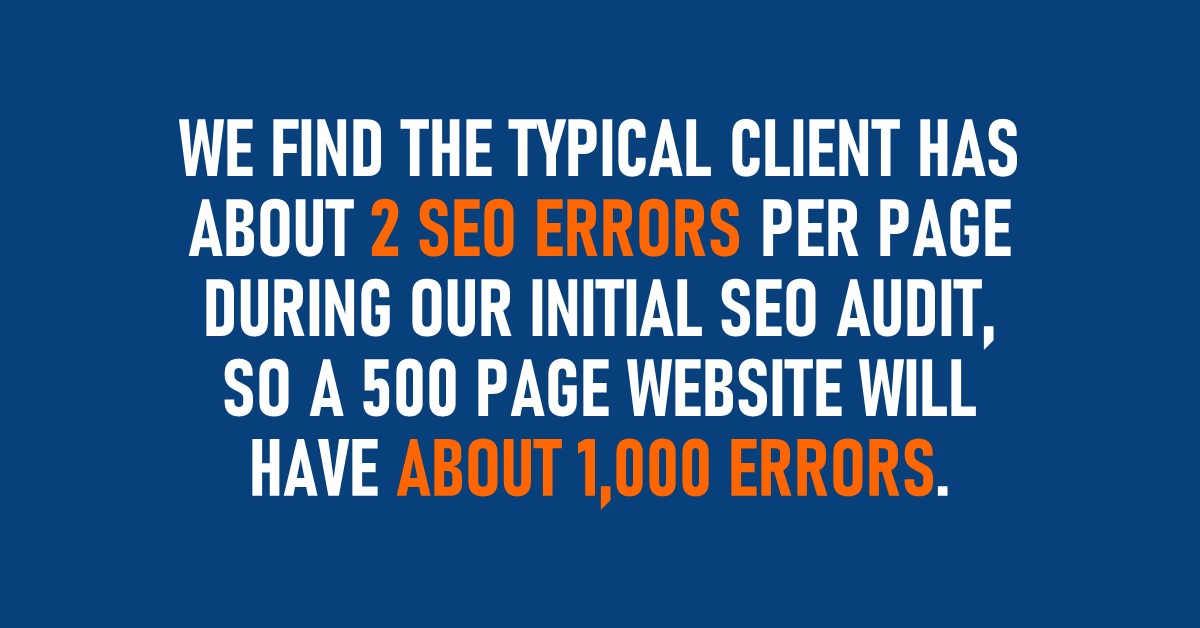5 Ways To Fix Your Website Blog Post
Let’s Fix Your Website
At Elbow Grease Marketing, we test more than 100 elements when evaluating and optimizing our clients’ websites. We have found that the five most effective ways to optimize your website are:
- Lead with a customer-centric value proposition.
- Convert with a crystal clear call to action.
- Fix search engine optimization errors.
- Accelerate site speed.
- Optimize for mobile visitors.
1. Lead with a customer-centric value proposition
A prominent and powerful value proposition tells your visitors why your business is the best choice for them. Your value proposition should answer two simple questions right on your home page. What do you do and how are you different from your competition? Most companies know what they do, but struggle to quickly get to the point. You’ll often see value propositions like this, “We do this and this and this, oh and this and this. Plus, we started doing this and this.” Instead, for your home page, try to simply communicate your unique value proposition. Save the kitchen sink list of all the things you do for your product or services pages. If a user can understand your value proposition in less than five seconds, your home page is off to a great start. Check out our home page to see this in action.
2. Convert with a crystal clear call to action (CTA)
Your home page call to action(s) should be crystal clear to visitors. Now that they’ve found you, how are you going to entice them to take the next step. You need to answer the question “what’s in it for me?” Offer something of value to keep your visitors engaged. Whether that is access to thought leadership content in exchange for the their contact info, clicking through to learn more about how you can solve their problem, or something else – a crystal clear home page CTA will keep your visitor’s moving through the funnel. Be sure to use simple, direct language and make your CTA action-oriented to create urgency. Position it prominently, and if possible, in multiple places on your home page.
3. Fix search engine optimization (SEO) errors
There is no question that SEO errors will hurt your search rankings, preventing potential buyers from finding you on the web. At Elbow Grease Marketing, we use several tools to identify SEO errors. These errors range from relatively minor technical issues that have little impact on your rankings to costly keyword strategy problems that prevent the right visitors from finding you. The average website has about 2 errors per page. So, a 500 page website probably has about 1,000 errors. Google penalizes the search engine rankings companies that have many errors. If you would like to see how well your website SEO is working, request a free website audit.
4. Accelerate site speed
Most everyone wants a fast car but why are so many websites slow to load? A study from MachMetrics found that the average perceived loading time, or speed index was 4.7 seconds on desktop and 11.4 seconds on mobile. That is an eternity and many visitors will move on instead of waiting. Google also punishes sites that take longer than 3 seconds to load, dropping them lower in their search results. A number one Google search rank gets about 31% of clicks, while a tenth place result gets only about 3% of traffic. How fast is your website? Ours is currently 1.79 seconds. If you want to speed up your website, start with reviewing your hosting provider and reducing your home page file size.
5. Optimize for mobile visitors
With nearly 54% of website traffic coming from mobile devices, it’s imperative that your site be optimized for mobile visitors. Most websites are designed to be mobile “responsive.” But that does not mean they are mobile-optimized. Bookmark your website on your phone and visit it periodically. Is it easy to navigate? Do all the images render correctly? Test your site using Google’s free Mobile Friendly Test Tool, use a responsive website theme, and keep your site copy short and to the point.
Conclusion
While there are many more factors to consider, focusing your time and energy on these five key website priorities will ensure you make sure your website is optimized to attract, engage and convert visitors. And don’t forget, we are available to help with your website design and search engine optimization.







